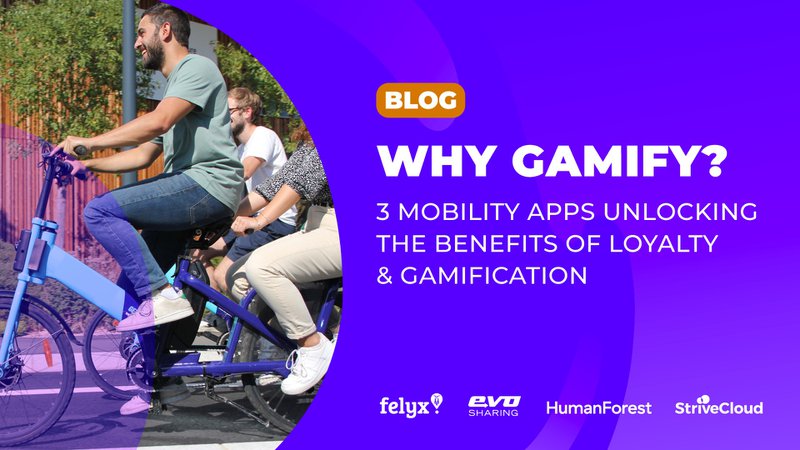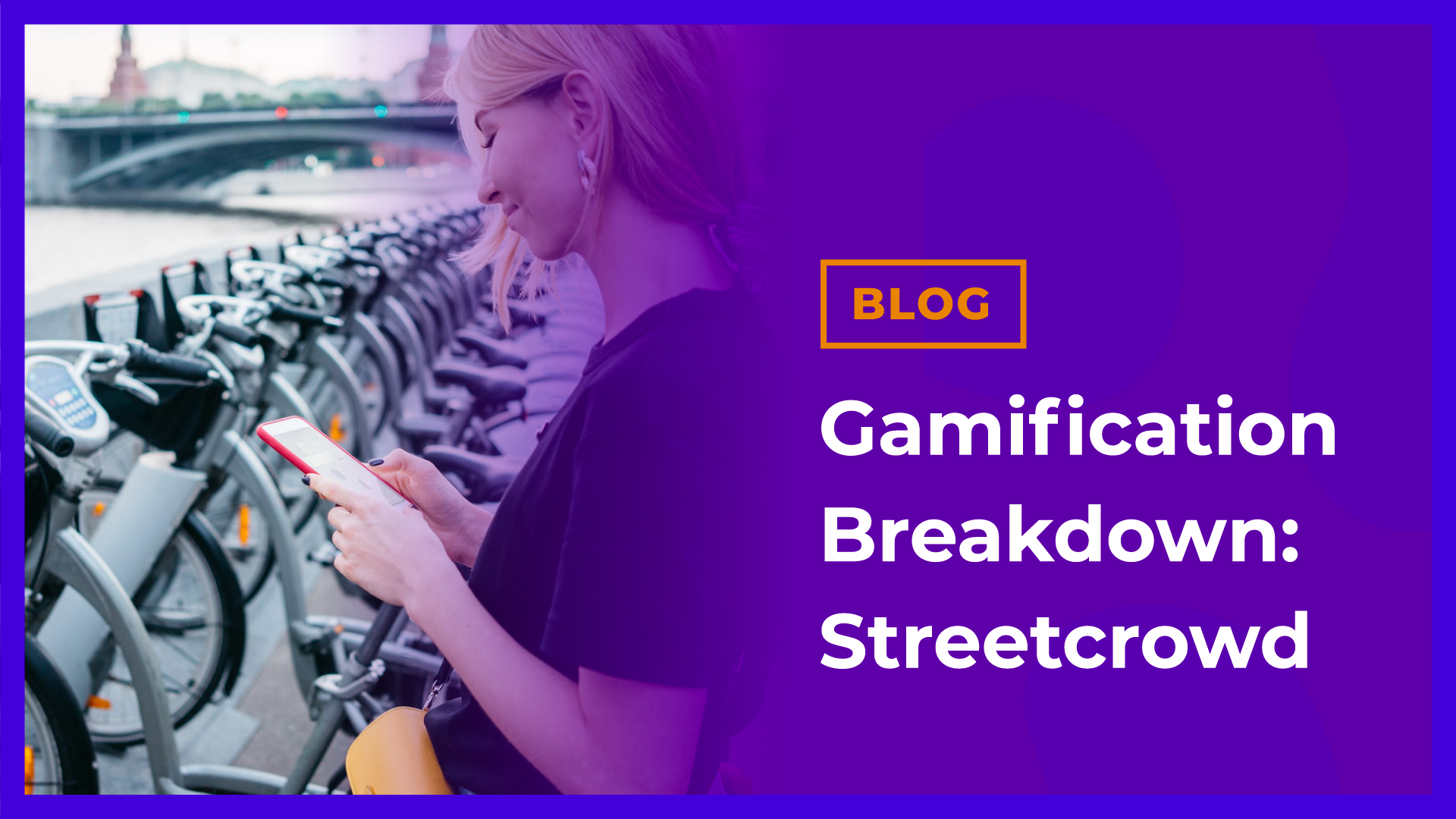

Why gamify? 3 mobility apps unlocking the benefits of mobility app gamification
Why gamify? 3 mobility apps unlocking the benefits of mobility app gamification
Leveraging gamification in your mobility service leads to many benefits. But to get the advantages, you also need to avoid the potential pitfalls! What makes or breaks an effective gamification strategy? And how do you set up a working plan?

In this article, we'll explore successful examples of mobility app gamification and what can be learned from them.
- What are the benefits of mobility app gamification?
- 3 successful examples of gamification in mobility services
- When gamification of your mobility service can backfire (and how to avoid that!)
- FAQs
What are the benefits of mobility app gamification?
#1 Increased customer engagement
It’s simple - when your app is fun to use, customers are more motivated to come back. In short, that means your customers will complete more trips! This fact is supported by the results of a recent study that tested mobility app gamification in cities across Europe.
Innovation for Sustainable Cities - "When using a mobility app that incorporates gamified elements, citizens are motivated to cycle more and to explore more points of interest in the city."
#2 Enhanced customer loyalty
Customers become loyal to you when you recognize and reward their participation. To do that, most loyalty programs use extrinsic rewards like discounts. But that also comes with some drawbacks. When people are only motivated by the reward, eventually motivation will dry up. You can either increase your spending on discounts or leverage gamification!
Gamification re-introduces unpredictability and fun into the experience! It helps you get passed the point of diminishing returns. Instead of a tangible prize, gamification plays on what we call ‘intrinsic rewards’. That means fulfilling psychological needs such as the desire for status, connection, or achievement. In fact, research from the University of Louvain finds that intrinsic rewards like those used in gamification are more effective at fostering long-term loyalty!
What drives customer participation in loyalty programs? - "Extrinsic rewards decrease customer loyalty as they draw the attention from the brand to the reward, and thereby, lower customers’ intrinsic motivation... but intrinsic rewards are particularly effective at enhancing brand loyalty."
#3 Higher customer satisfaction
Customer satisfaction is the ultimate prize! Mobility app gamification helps you stand out and be remembered. It gives customers a reason to choose you over competitors. Additionally, a happy customer is one that spreads the word - and referred customers are 16% more valuable than average!
The role of gamification in mobile apps - "Gamification increases customer engagement through satisfaction of the needs for competence, autonomy, and relatedness. In turn, engagement leads to greater intention to use and positively rate the app."
#4 Elevated ARPU
Besides being great for branding, mobility app gamification also boosts the average revenue per customer! Customers are likely to spend more, and more often! This allows you to improve overall profitability.
Given the competitiveness of the industry, it’s no surprise that mobility services use gamification to increase ARPU.
The power to boost ARPU comes from how gamification makes your mobility app more engaging. An analysis by Gallup finds that disengaged customers generate 13% less revenue than average, whereas fully engaged customers are 23% more profitable!
Get started with gamification today & sell up to 3X more trips!
3 successful examples of gamification in mobility services
When we say mobility app gamification works, we’re talking from experience. In fact, our customers in shared mobility see an average return of 200% more trips after the gamification of their mobility service.
HumanForest
How did HumanForest stop 220 tons of CO2 from entering London’s air? With their mobility service powered by gamification! When HumanForest wanted to encourage more customers on their e-bikes, we created a gamified loyalty program together. To achieve the desired results, we used multiple elements of mobility app gamification:
- Earn TreeCoins based on the distance covered & exchange them for free-riding minutes!
- Complete challenges to earn more TreeCoins! (And save more CO2!)
- Use your TreeCoins to enter a lottery system & win awesome prizes!
- Rank on a CO2 leaderboard based on the amount of CO2 you saved!
- Level up from a tiny Bonzai tree all the way up to a Sequoia tree!
Michael Stewart @Human Forest - "On one hand, we wanted to create a fun and engaging experience around the concept of HumanForest. On the other hand, we wanted to show our customers the impact they were having on the planet."
Since implementing gamification, HumanForest e-bikes now make over 150,000 trips monthly across London. Even better, 70% of those trips are made by repeat customers!
Want to grow your service like HumanForest? Discover how our mobility app gamification experts can help you!

HumanForest uses a challenge system to encourage specific user actions, directly tying engagement to CO2 savings and tangible rewards.
EVO Sharing
One of the first things that new customers of EVO Sharing see is an empty state: they’re a rookie with 0 minutes, 0 EVOCoins, and 0 kilometers to their name. But getting started is easy! To spur customers on, the screen shows what newbies need to earn and how to do it. For example, customers see that they only need 602xp to level up. Seems doable, right?
Once you start using EVO Sharing, you’re motivated to come back. Each action leads to a progress driver and eventually builds up to a reward. This creates an inherent loop of positive reinforcement. In other words, customers return to EVO Sharing because they want to experience that same rush again!
EVOCoins are a great example of this positive feedback loop:
- EVOCoins rewards customers for the number of kilometers they ride.
- Customers can use EVOCoins to buy extra riding minute packages.
- Finally, this reinforces loyalty and increases buying frequency!
Jennifer Dittmar @EVO Sharing - "Our business model is very suitable for gamification. Receiving rewards based on distance, kilometers, or minutes driven makes a lot of sense to use and goes well together."

EVO Sharing's achievement system clearly visualizes user progress and rewards, motivating customers to continue using the service to unlock the next level.
Felyx
Competition is tough and bigger operators will always have lower prices than you. That’s unfortunate because consumers name “competitive price” as the No. 2 most important feature of a mobility service - second only to safety.
Luckily mobility app gamification can help you overcome this challenge! To encourage customer loyalty, Felyx customers pay less the more they ride! To get an upgrade, customers must earn points by riding more. Why is this so effective? Because loyal customers expect this better treatment! This is called the “Lucky Loyalty effect”, which says that customers feel that perks and discounts should scale with their loyalty.
In short, by rewarding your loyal customers, you extend their loyalty and lifetime value!

Felyx implements a tiered loyalty system where increased usage unlocks better pricing, demonstrating the "Lucky Loyalty effect" in action.
When gamification of your mobility service can backfire (and how to avoid that!)
All in all, it’s important to remember that the gamification of your mobility service is about more than handing out rewards. You need to create a strategy that keeps customers engaged in the long term.
Given this, here are some drawbacks to look out for:
Too complex, with no clear path of action
Part of what makes gamification so useful is how it guides the customer journey. When done right, you can set up a clear path of actions linked to rewards to get customers to do exactly what you want. It works best when you keep it simple. Think of a “do this to get that” mechanism, for instance: fill out your profile to level up.
It’s tempting to keep adding new features to your experience, however, this will only lead to overwhelm. A great gamified experience combines different gamified elements into one coherent experience and narrative.
Rewards are too plentiful or too easy to get
If rewards are too easy, they lose their purpose! Think about it - if customers are rewarded for putting in zero effort, why should they try to earn the next one? On that note, overusing rewards can also cause customers to quit.
What drives customer participation in loyalty programs? - "Customers can become annoyed by an excessive amount of rewards to the extent that they consider unsubscribing."
Rewards are too difficult to get
On the other hand, your rewards shouldn’t be too difficult to achieve! For customers, impossible rewards result in a lack of progress and growth which can be super frustrating.
The power lies in finding the right balance between challenge and motivation.

This visual represents the Fogg Behavior Model, which highlights the importance of balancing user motivation, ability, and prompts to drive desired actions.
You put customers in a losing state
When done right gamification fuels motivation by creating “win states”. However, the opposite can also be true! For instance, when customers fail to complete a challenge, drop on the leaderboard ranking, or lose their daily streak. It gives a feeling of having lost all previous progress and built-up benefits which actually works demotivating.
There are workarounds though! For instance, you can segment people into different leaderboard levels so it always feels like they’re part of the top people!
Create a proven gamification strategy in an expert-led workshop & learn how to sell 3X more trips with mobility app gamification!
FAQs
What are the benefits of mobility app gamification?
Mobility services with gamification benefit from higher customer engagement. It's simple - gamification makes your app more fun to use! And higher engagement increases customer satisfaction and the average revenue per user. In fact, fully engaged customers are 23% more profitable than average!
How does mobility service gamification boost customer loyalty?
Instead of hard rewards like discounts, gamification offers intrinsic rewards. That means psychological benefits like fulfilling the need for personal growth. And research finds that intrinsic rewards like those used in gamification are more effective at fostering loyalty than hard rewards!
How does mobility app gamification improve customer engagement?
When your app is more fun to use, customers are more motivated to use it. In short, that means your customers will take more trips! Indeed, a recent study found that mobility service gamification made people significantly more motivated to cycle.
Related Posts

Immediately improve App Acquisition, Engagement and Retention with Gamification
Shared mobility providers are struggling to achieve profitability because competing at the price level is the only way to acquire and retain customers. What if we told you there's a smarter way to acquire more customers, engage them without losing money? Fire up your acquisition and retention game by gamifying your mobile app experience.

How gamification helps Streetcrowd fight the greatest challenge in shared mobility
In 2020 app uninstall rates shot up by 70%! The same goes for the shared mobility sector. With competition growing fierce, apps like Uber and Streetcrowd want to create customer loyalty by increasing user retention. Gamification helps Streetcrowd achieve this, as well as tackling the greatest challenge in shared mobility... Read the full article to find out more!

